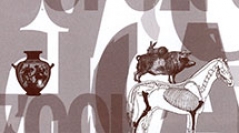

 Anthropozoologica
47 (2) - Pages 63-76
Anthropozoologica
47 (2) - Pages 63-76Routes of migration and exchange are important factors in the debate about how the Neolithic transition spread into Europe. Studying the genetic diversity of livestock can help in tracing back some of these past events. Notably, domestic goat (Capra hircus) did not have any wild progenitors (Capra aegagrus) in Europe before their arrival from the Near East. Studies of mitochondrial DNA have shown that the diversity in European domesticated goats is a subset of that in the wild, underlining the ancestral relationship between both populations. Additionally, an ancient DNA study on Neolithic goat remains has indicated that a high level of genetic diversity was already present early in the Neolithic in northwestern Mediterranean sites. We used coalescent simulations and approximate Bayesian computation, conditioned on patterns of modern and ancient mitochondrial DNA diversity in domesticated and wild goats, to test a series of simplified models of the goat domestication process. Specifically, we ask if domestic goats descend from populations that were distinct prior to domestication. Although the models we present require further analyses, preliminary results indicate that wild and domestic goats are more likely to descend from a single ancestral wild population that was managed 11,500 years before present, and that serial founding events characterise the spread of Capra hircus into Europe.
Capra, goat, domestication, coalescent, mtDNA, Neolithic diffusion, approximate Bayesian Computation (ABC).